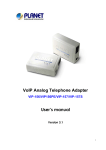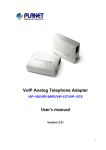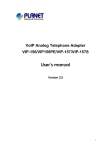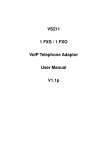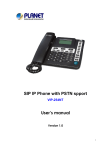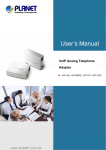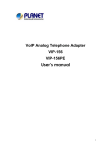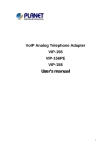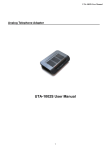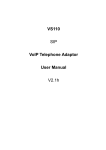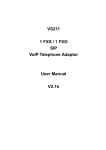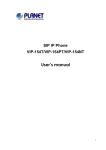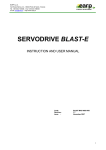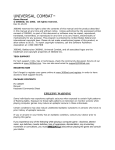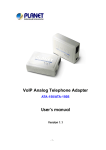Download VoIP Analog Telephone Adapter User`s manual
Transcript
VoIP Analog Telephone Adapter VIP-156/VIP156PE/VIP-157/VIP-157S User’s manual Version 3.01 1 Copyright Copyright (C) 2007 PLANET Technology Corp. All rights reserved. The products and programs described in this User’s Manual are licensed products of PLANET Technology, This User’s Manual contains proprietary information protected by copyright, and this User’s Manual and all accompanying hardware, software, and documentation are copyrighted. No part of this User’s Manual may be copied, photocopied, reproduced, translated, or reduced to any electronic medium or machine-readable form by any means by electronic or mechanical. Including photocopying, recording, or information storage and retrieval systems, for any purpose other than the purchaser' s personal use, and without the prior express written permission of PLANET Technology. Disclaimer PLANET Technology does not warrant that the hardware will work properly in all environments and applications, and makes no warranty and representation, either implied or expressed, with respect to the quality, performance, merchantability, or fitness for a particular purpose. PLANET has made every effort to ensure that this User’s Manual is accurate; PLANET disclaims liability for any inaccuracies or omissions that may have occurred. Information in this User’s Manual is subject to change without notice and does not represent a commitment on the part of PLANET. PLANET assumes no responsibility for any inaccuracies that may be contained in this User’s Manual. PLANET makes no commitment to update or keep current the information in this User’s Manual, and reserves the right to make improvements to this User’s Manual and/or to the products described in this User’s Manual, at any time without notice. If you find information in this manual that is incorrect, misleading, or incomplete, we would appreciate your comments and suggestions. CE mark Warning The is a class B device, In a domestic environment, this product may cause radio interference, in which case the user may be required to take adequate measures. WEEE Warning To avoid the potential effects on the environment and human health as a result of the presence of hazardous substances in electrical and electronic equipment, end users of electrical and electronic equipment should understand the meaning of the crossed-out wheeled bin symbol. Do not dispose of WEEE as unsorted municipal waste and have to collect such WEEE separately. Trademarks The PLANET logo is a trademark of PLANET Technology. This documentation may refer to numerous hardware and software products by their trade names. In most, if not all cases, their respective companies claim these designations as trademarks or registered trademarks. 2 Revision User’s Manual for PLANET VoIP Analog Telephone Adapter: Model: ATA Rev: 3.01 (2007, July) Part No. EM-VIP_ATAV3.01 3 TABLE OF CONTENTS Chapter 1 ................................................................................................................................... 6 Introduction .............................................................................................................................. 6 Overview ....................................................................................................................................................... 6 Package Content .......................................................................................................................................... 7 Physical Details ............................................................................................................................................ 7 LED Display & Button....................................................................................................................... 10 Chapter 2 Preparations & Installation................................................................................. 12 Physical Installation Requirement............................................................................................................ 12 LAN IP address configuration via web configuration interface ......................................................... 13 Chapter 3 Network Service Configurations......................................................................... 17 Configuring and monitoring your ATA from web browser .................................................................... 17 Overview on the web interface of ATA .............................................................................................. 17 Manipulation of ATA via web browser ............................................................................................... 17 Chapter 4 VoIP Telephone Adapter Configurations............................................................ 19 Phone Book ........................................................................................................................................ 19 Call forward........................................................................................................................................ 20 SNTP settings ..................................................................................................................................... 22 Volume Setting ................................................................................................................................... 22 Block Setting ...................................................................................................................................... 23 Auto Answer (For VIP-157)............................................................................................................... 24 Caller ID settings................................................................................................................................ 24 Dial Plan Settings ............................................................................................................................... 25 Flash Time Setting.............................................................................................................................. 27 Call waiting Settings .......................................................................................................................... 27 T.38 (FAX) Settings............................................................................................................................ 28 Hot line Settings ................................................................................................................................. 28 Alarm Settings.................................................................................................................................... 29 DDNS Settings ................................................................................................................................... 29 Service Domain Settings .................................................................................................................... 30 Port Settings ....................................................................................................................................... 31 Codec Settings.................................................................................................................................... 32 Codec ID Setting ................................................................................................................................ 32 DTMF Setting .................................................................................................................................... 33 RPort Settings..................................................................................................................................... 33 Other Settings ..................................................................................................................................... 34 STUN settings .................................................................................................................................... 34 Auto Configuration............................................................................................................................. 35 4 ICMP Settings .................................................................................................................................... 36 Cancel without to tag.......................................................................................................................... 36 PTT Settings ....................................................................................................................................... 36 System Authority................................................................................................................................ 37 Save & Reboot ................................................................................................................................... 37 Firmware Upgrade.............................................................................................................................. 38 Auto Upgrade ..................................................................................................................................... 39 Reset to Default .................................................................................................................................. 40 Reboot without saving........................................................................................................................ 41 Appendix A Voice Communication Samples......................................................................................... 42 Case 1: ATA to ATA connection via IP address .................................................................................. 42 Case 2: (Peer-to-Peer mode) VIP-157S Port 1 to Port 2 communications ......................................... 43 Case 3: Voice communication via SIP proxy server – SIP-50 ............................................................ 44 Case 4: Voice communication via IP PBX system – IPX-2000 (Auto-config)................................... 46 Case 5: Call Forward Feature_Example 1 .......................................................................................... 50 Case 6: Call Forward Feature_Example 2 .......................................................................................... 52 Case 7: Call Forward Feature_Example 3 .......................................................................................... 54 Case 8: Call Forward Feature_Example 4 .......................................................................................... 56 Case 9: Auto Answer Feature_IP to PSTN ......................................................................................... 57 Case 10: Auto Answer Feature_PSTN to IP ....................................................................................... 59 Appendix B The method of operation guide............................................................................................ 61 Call Transfer ....................................................................................................................................... 61 3-Way Conference .............................................................................................................................. 61 Call Waiting........................................................................................................................................ 61 Switch the Realm (Registration Proxy Server)................................................................................... 61 Auto Update firmware by manual (Keypad) ...................................................................................... 62 Appendix C VIP-156/VIP-156PE/VIP-157/VIP-157S Specifications..................................................... 63 5 Chapter 1 Introduction 1 Overview Based on years of VoIP manufacturing experiences, PLANET Technology VoIP total solutions are known for advanced implementation of standards based telephony with mass deployment capability. Cost-effective, easy-to-install and simple-to-use, the PLANET VIP-156/VIP-157/VIP-157S VoIP Phone Adapter (“ATA” in the following term) converts standard telephones to IP-based networks. The service providers and enterprises offer users traditional and enhanced the telephony communication services via the existing broadband connection to the Internet or corporation network. With the ATA, home users and companies are able to save the installation cost and extend their past investments in telephones, conference and speakerphones. The ATA can be the bridge between traditional analog systems and IP network with an extremely affordable investment. The ATA includes two alternatively Ethernet interface for Internet (PPPoE, DHCP or Fixed IP), or office LAN connection. With adding the auto-provision feature of our IP PBX product - IPX-2000, the ATA can be seamlessly integrated into the telephony network and be used in consumer and business IP telephony service, no expertise required! The ATA and our IP PBX system integration are the ideal combination for your office daily communications. Product Features • Feature-rich telephone service over home or office Internet/Intranet connection • Auto-config feature for flexible, ease-of-use IP PBX system integration • Cost effective, field proven compatibility, and stability • Web-based and telephone keypad machine configuration • Remote machine administration authentication • Voice prompt for machine configurations VoIP Features • SIP 2.0 (RFC3261) compliant • Peer-to-Peer / SIP proxy calls • Voice codec support: G.711, G.723.1, G.729A/G.729B • T.38 FAX transmission over IP network 6 • Voice processing: Voice Active Detection, DTMF detection/ generation, G.168 echo cancellation (16mSec.), Comfort noise generation (CNG) • In band, out-of-band, and SIP-info DTMF support Package Content The contents of your product should contain the following items: VoIP Telephone Adapter Power adapter Quick Installation Guide User’s Manual CD RJ-11 cable x 1 Physical Details The following figure illustrates the front/rear panel of ATA. Respective model/descriptions are shown below: VIP-156: SIP Analog Telephone Adapter VIP-156PE: 802.3af PoE SIP Analog Telephone Adapter VIP-157: 1 FXS/ 1 FXO SIP Analog Telephone Adapter VIP-157S: 2-port FXS SIP Analog Telephone Adapter Front Panel of VIP-156 7 Left / Right Panel of VIP-156 Front Panel of VIP-156PE Left / Right Panel of VIP-156PE 8 Front Panel of VIP-157 Left / Right Panel of VIP-157 Front Panel of VIP-157S 9 Left / Right Panel of VIP-157S LED Display & Button 1 PC RJ-45 connector, to maintain the existing network structure, connected directly to the PC through straight CAT-5 cable RJ-45 connector, for Internet access, connected directly to 2 LAN Switch/Hub through straight CAT-5 cable. The LAN interface also can be connected with 802.3af PoE switch or converter for power supply (VIP-156PE) 3 12V DC 4 Reset Note 12V DC Power input outlet Reset to the factory default setting Machine default IP is http://192.168.0.1. Press RESET button on rear panel over 5 seconds will reset the VoIP Phone Adapter to factory default value. (Except speed dial and call forward settings) 10 LED display of VIP-156 / VIP-156PE LED Indicators Descriptions PWR Power is supplied to the device. STATUS The Status LED will be flashing when the machine is operational LNK/ACT OFF: the device is connected to LAN at 10Mb/s. ON: the device is connected to LAN at 100Mb/s. RING OFF: the phone is idle. ON: the phone is in use (offhook). Blinking: the phone is ringing. LED display of VIP-157 / VIP-157S LED Indicators Descriptions STATUS The Status LED will be flashing when the machine is operational LNK/ACT OFF: the device is connected to LAN at 10Mb/s. ON: the device is connected to LAN at 100Mb/s. RING 1 OFF: the phone is idle. ON: the phone is in use (offhook). Blinking: the phone is ringing. RING 2 OFF: the phone is idle. ON: the phone is in use (offhook). Blinking: the phone is ringing. 11 Chapter 2 Preparations & Installation 2 Physical Installation Requirement This chapter illustrates basic installation of ATA analog Phone Adapter ((“ATA” in the following term)) • Network cables. Use standard 10/100BaseT network (UTP) cables with RJ45 connectors. • TCP/IP protocol must be installed on all PCs. For Internet Access, an Internet Access account with an ISP, and either of a DSL or Cable modem Administration Interface PLANET ATA provides GUI (Web based, Graphical User Interface) for machine management and administration. Web configuration access To start ATA web configuration, you must have one of these web browsers installed on computer for management • Microsoft Internet Explorer 4.01 or higher with Java support Default LAN interface IP address of ATA is 192.168.0.1. You may now open your web browser, and insert http://192.168.0.1 in the address bar of web browser to logon ATA web configuration page. ATA will prompt for logon username/password, please enter: root / null (no password) to continue machine administration. 12 Note Please locate your PC in the same network segment (192.168.0.x) of ATA. If you’re not familiar with TCP/IP, please refer to related chapter on user’s manual CD or consult your network administrator for proper network configurations. LAN IP address configuration via web configuration interface Execute your web browser, and insert the IP address (default: 192.168.0.1) of VIP in the adddress bar. After logging on machine with username/password (default: root / no passwrd), browse to “Network” --> “Network settings” configuration menu: Parameter Description IP address LAN IP address of ATA Default: 192.168.0.1 Subnet Mask LAN mask of ATA Default: 255.255.255.0 Default Gateway Gateway of ATA Default: 192.168.0.254 Network settings via Keypad commands The ATA series phone adapters support telephone keypad configurations, please connect analog 13 telephone set and refer to the following table for machine network configurations. IVR Menu Choice #111# #112xxx*xxx*xxx* xxx# #113xxx*xxx*xxx* xxx# #114xxx*xxx*xxx* xxx# #115xxx*xxx*xxx* xxx# Machine operation Set DHCP client Setup Static IP Address Parameter(s) Notes: ATA will change to DHCP None Client Use the * (star) key DHCP will be disabled and when entering a decimal system will change to the point. Static IP type. Use the * (star) key Set Network Mask when entering a decimal Must set Static IP first. point. Use the * (star) key Set Gateway IP Address when entering a decimal Must set Static IP first. point. Use the * (star) key Set Primary DNS Server when entering a decimal Must set Static IP first. point. Must unlock the protect #190# Unlock function before set up None network settings and ATA function via keypad. The system will be lock #191# Lock None and can’t set up network settings via keypad. #195# Reboot The system will reboot None automatically. The system will be reset to #198# Factory Reset None factory default value and reboot automatically. 0 To switch PSTN mode None VIP-157 only Following keypad commands can be used to display the network settings enabled on ATA via voice prompt. IVR Menu Choice Machine operation #120# Check IP Address #121# Check network connection Type #122# Check the Phone Number Notes: IVR will announce the current IP address of the ATA. IVR will announce if DHCP in enabled or disabled. IVR will announce current enabled VoIP number. 14 IVR will announce the current network mask #123# Check Network Mask #124# Check Gateway IP Address #125# Check Primary DNS Server Setting #128# Check Firmware Version of the ATA. IVR will announce the current gateway IP address of the ATA. IVR will announce the current setting in the Primary DNS field. IVR will announce the version of the firmware running on the ATA. Following keypad commands can be used to set up the main function . IVR Menu Choice Machine operation Parameter(s) Notes: #138# Enable call waiting None Enable Call waiting #139# Disable call waiting None Disable Call waiting #160# Update firmware None Update firmware #510# Blind Transfer ATA Bland Transfer #511# Attendant Transfer ATA Attendant Transfer #512# 3-way calling ATA 3-way calling #514# IP transfer to PSTN ATA transfer IP call to PSTN side 1:G.711 u-Law, 2: G.711 a-Law, 3: G.723.1, 4: #130+[1~8]# Set Codec G.729a, 5: G.726 16K, 6: G.726 24K, 7: G.726 You can set the codec you want to the first priority. 32K, 8: G.726 40K, #131+[00~15]# #132+[00~12]# #135xxx*xxx*xxx* xxx# #136xxx*xxx*xxx* xxx# Set Handset Gain Set Handset Volume TFTP Server IP Address FTP Server IP Address Handset Gain from 0~15 Handset Volume from 0~12 You can set the Handset gain to proper value, default is 10 You can set the Handset volume to proper value, default is 10 Set Auto config TFTP You can set the TFTP Server IP Address Server IP address Set Auto config FTP You can set the FTP Server IP Address Server IP address You can set the Auto #137+[0~2]# Auto config mode 0: Disable, 1: TFTP configuration mode, 0: mode, 2: FTP mode Disable, 1: use TFTP Server, 2: user FTP Server 15 #145# #146+Number# #147+Number# Forward function disable Disable forwrad funciton enable forward to FXS Eanble forward to FXS Port Port enable forward to FXO Eanble forward to FXO Port Port Hint Please contact your Internet service provider to obtain the Internet access type, and select the proper network settings in ATA to establish the network connections. After confirming the modification you’ve done, Please click on the Submit button to apply settings and browse to “Save & Reboot” menu to reboot the machine to make the settings effective. Connection Type Data required. Fixed IP In most circumstances, it is no need to configure the DHCP settings. DHCP clinet The ISP will assign IP Address, and related information. PPPoE The ISP will assign PPPoE username / password for Internet access, Hint Please consult your ISP personnel to obtain proper PPPoE/IP address related information, and input carefully. If Internet connection cannot be established, please check the physical connection or contact the ISP service staff for support information. Save Modification to Flash Memory Most of the VoIP router parameters will take effective after modifications, but it is just temporary stored on RAM only, it will disappear after your reboot or power off the VoIP Phone Adapter, to save the parameters into Flash ROM and let it take effective forever, please remember to press the Save & Reboot button after you modify the parameters. 16 Chapter 3 Network Service Configurations 3 Configuring and monitoring your ATA from web browser The ATA integrates a web-based graphical user interface that can cover most configurations and machine status monitoring. Via standard web browser, you can configure and check machine status from anywhere around the world. Overview on the web interface of ATA With web graphical user interface, you may have: More comprehensive setting feels than traditional command line interface. Provides user input data fields, check boxes, and for changing machine configuration settings Displays machine running configuration To start ATA web configuration, you must have one of these web browsers installed on computer for management Microsoft Internet Explorer 4.01 or higher with Java support Manipulation of ATA via web browser Log on ATA via web browser After TCP/IP configurations on your PC, you may now open your web browser, and input http://192.168.0.1 to logon Phone Adapter web configuration page. Phone Adapter will prompt for logon username/password: root / null (no password) ATA log in page When users login the web page, users can see the Phone Adapter system information like firmware version, company…etc in this main page. 17 VoIP Phone Adatper main page 18 Chapter 4 VoIP Telephone Adapter Configurations 4 Phone Book ATA can set up 140 records of Phone Book. User can dial the Name records to make calls via Phone Book feature. Field Phone Book Page Phone Name URL Select Description The default is Page 1. It can select Page1 ~ Page 14 to look round Phone Book records. The record number from 0 ~ 139, it can set up 140 records in total. The name of Phone Book records, it only can input numerals. Fill in the outgoing number (Line Number) or IP address. To select this record. 19 If you need to add a phone number into the Phone Book list, you need to input the position, the name, and the phone number (by URL type). When you finished a new phone list, just click the “Add Phone” button. If you want to delete a phone number, you can select the phone number you want to delete then click “Delete Selected” button. If you want to delete all phone numbers, you can click “Delete All” button. For Example: Ex_1: ATA had added the above phone numbers. User pick up the handset and dial the “301” to make the P2P call ([email protected]). Ex_2: Users pick up the handset and dial the “206” to make the Proxy call (17476433364). Ex_3: Users pick up the handset and dial the “202” to make the P2P call (192.168.1.2:5062). Call forward This page defines Call Forward function. You can setup the phone number you want to forward in this page. There are three type of Forward mode. You can choose All Forward, Busy Forward, and No Answer Forward by click the icon. All Forward: All incoming call will forward to the number you chosen. You can input the name and the phone number in URL field. If you select this function, then all the incoming call will direct forward to the 20 speed dial number you choose. Busy Forward: If you are on the phone, the new incoming call will forward to the number you choosed. You can input the name and the phone number in URL field. No Answer Forward: If you can not answer the phone, the incoming call will forward to the number you chosen. You can input the name and the phone number in URL field. Also you have to set the Time Out time for system to start to forward the call to the number you choosed. When you finished the setting, please click the Submit button. Call Forward function for VIP-156/VIP-156PT/VIP-157S Call Forward to PSTN (VIP-157): VIP-157 not only support Call Forward to IP calls, but also can forward the calls to PSTN. You can choose the Call Forward type with PSTN, then input the name and the PSTN number in URL/Number field. 21 Call Forward function for VIP-157 SNTP settings This page defines the primary and second SNTP Server IP Address, to get the date/time information. Also you can base on your location to set the Time Zone, and how long need to synchronize again. When you finished the setting, please click the Submit button. Volume Setting This page defines the Handset Volume, Ringer Volume, and the Handset Gain. When you finished the setting, please click the Submit button. Handset Volume is to set the volume for you can hear from the handset. Handset Gain is to set the volume send out to the other side’s handset. 22 Volume Settings for VIP-154T/VIP-154PT Beside the above settings, VIP-157 also can set the volume of PSTN. PSTN-Out Volume is to set the PSTN volume for you can hear. PSTN-In Gain is to set the volume send out to the other side’s handset. Volume Settings for VIP-157 Block Setting This page defines the Block Setting to keep the phone slience. You can choose Always Block or Block a period. Always Block: All incoming call will be blocked until disable this feature. Block Period: Set a time period and the phone will be blocked during the time period. If the “From” time is large than the “To” time, the Block time will from Day 1 to Day 2. When you finished the setting, please click the Submit button. 23 Auto Answer (For VIP-157) This page defines the Auto Answer function. You can set the Auto Answer function to answer the incoming call by the phone. If the call is come from the IP, then the VIP-157 can let user to redial the call to PSTN phone number. If the call is coming from PSTN, then the VIP-157 can let user to redial to IP Phone number. Auto Answer Counter is to set after the ring count met the number you set then the auto answer will enable. For security issue, You’d better to set the PIN Code. If you have set the PIN code, you will hear a tone to inform you input the PIN Code then you can dial out. Caller ID settings This page defines the device to show Caller ID in your PSTN Phone or IP Phone. There are four selection of Caller ID. You need to base on your environment to set the Caller ID function for FSK or DTMF. 24 Dial Plan Settings This page defines the Dial Plan Setting function. This function is when you input the phone number by the keypad but you don’t need to press “#”. After time out the system will dial directly. Field Description Drop Prefix The rule of add or replace code. If setup as No, it will add the prefix number prior to the identification number. If setup as Yes, it will replace the identification number. Replace rule The prefix number. It only accept the numeral and the max length is 8. + The identification number. It can accept the numeral or symbol and the max length is 40. - Symbol: It only accept the [+], [x] - +: It means as “or”. For example, [123+456+334+5xx] even if [123 or 456 or 334 or 5xx] - x: It is equal to 0~9. For example, [5xx] even if the number begin 5. Dial Now If the dialing number are match with this field, it will dial out and need not to press the “#” key to end the dialing. It accepts the numeral or symbol, and the max length are 124. Note: The starting number can’t be the “0”. For example, if the number is “0xxxx”, because the starting number is “0”, so that the 25 system will ignore this dial plan. Auto Dial Time Stop dialing after seconds then send dial number out. Use # as send key If setup as Yes, the symtem sill stop to receive the dialing number when receive the [#] key. The system also will to determine the Auto Dial Time, it will carry out the calling if there isn’t receive the digit after the Auto Dial Time. If setup as No, the system just according to the Auto Dial Time to determine the end time. Use * for IP dialing If setup as Yes, the system will look on [*] as [.]. For example, if dial the “192*168*0*100#”, it will dial out as “192.168.0.100#”. If setup as No, it just look on [*] as [*]. For example, if dial the “700*#”, it will dial out as “700*#”. Descriptions of example: Example_1: Drop prefix: No, Replace rule 1: 002, +: 1234+4321 (No limit the digit length) 1. If the dialing number is start as 1234 , it will add the 002 at begin. The real dialing number is [0021234 ]. 2. If the dialing number is start as 4321 , it will add the 002 at begin. The real dialing number is [0024321 ]. Example_2: Drop prefix: Yes, Replace rule 2: 006, +: 002+003+004 (No limit the digit length) 1. If the dialing number is start as 002 , it will replace 002 by 006. The real dialing number is [006 ]. 2. If the dialing number is start as 003 , it will replace 003 by 006. The real dialing number is [003 ]. Example_3: Drop prefix: No, Replace rule 3: 007, +: 5xxx+35xx (Has limit the digit length) 1. If the dialing number start as 5 and follow 3 digits, it will add the 007 at begin. The real dialing number is [0075xxx]. 2. If the dialing number start as 35 and follow 2 digits, it will add the 007 at begin. The real dialing number is [00735xx]. Example_4: Dial Now: *xx+#xx+11x+xxxxxx 1. If the dialing number is match with the rule of *xx , it will send out the dialing number directly. For example, *00/ *01/ *02 *99. 2. If the dialing number is match with the rule of #xx , it will send out the dialing number directly. For example, #00/ #01/ #02 #99. 3. If the dialing number is match with the rule of 11x , it will send out the dialing number directly. For example, 111/ 112/ 113 119. 4. If the dialing number is match with the rule of 8 digits, it will send out the dialing number directly. For example, 12345678. 26 Flash Time Setting When you use the PSTN Phone and you need to press the Hook to do the Flash (Switch to the other phone line or HOLD), this function is for you to set the time you press the Hook to represent the Flash function. Flash Time Settings for VIP-156/VIP-156PT/VIP-157S Beside the above settings, VIP-157 also can set the flash time of FXO port. Flash Time Settings for VIP-157 Call waiting Settings When you are talking with other people, You can choose If you want to hear the notice when there is a new coming call. If the call waiting function is On, if there is a new incomeing call, you will hear the call waiting notice in your current call. If you set the function to Off, then you will not hear any notice. 27 T.38 (FAX) Settings This page defines the T.38 (FAX) Setting function. You can Enable/Disable the T.38 function, and can modify the T.38 transmission port of each FXS port. T.38 (FAX) Settings for VIP-156/VIP-156PE/VIP-157 T.38 (FAX) Settings for VIP-157S Hot line Settings This page defines the Hot line setting in this page. When user pick up the handset, the device will call to the specific number automatically. Use Hot Line: Click Enable to carry the Hot line function out. Hot line number: The hot line number, it can input the IP address or registration number. 28 Alarm Settings This page defines the Alarm setting in this page. It provides the alarm function, and it can set up the Alarm Time to get the telephone ringed up every day. Alarm: The default is Off. If set up as On, the telephone will ringed up at the specific time. Alarm Time: It can set up the system prompt time with 24 hours. Current time: The next alarm time. DDNS Settings This page defines the DDNS setting in this page. You need to have the DDNS account and input the informations properly. You can have a DDNS account with a public IP address then others can call you via the DDNS account. But now most of the VoIP applications are work with a SIP Proxy Server. When you finished the setting, please click the Submit button. 29 Service Domain Settings In Service Domain Function you need to input the account and the related informations in this page, please refer to your ISP provider. You can register three SIP account in the ATA. You can dial the VoIP phone to your friends via first enable SIP account and receive the phone from these three SIP accounts. First you need click Active to enable the Service Domain, then you can input the following items: Display Name: you can input the name you want to display. Line number: you need to input the User Name get from your ISP. Register Name: you need to input the Register Name get from your ISP. Register Password: you need to input the Register Password get from your ISP. Domain Server: you need to input the Domain Server get from your ISP. Proxy Server: you need to input the Proxy Server get from your ISP. Outbound Proxy: you need to input the Outbound Proxy get from your ISP. If your ISP does not provide the information, then you can skip this item. You can see the Register Status in the Status item. If the item shows “Registered”, then your Phone Adapter is registered to the ISP, you can make a phone call direcly. If you have more than one SIP account, you can following the steps to register to the other ISP. When you finished the setting, please click the Submit button. 30 Note: ATA can register to three different SIP Proxies at the same time. It can receive any one of different SIP accounts incoming call, and it can switch to any one SIP accounts for making calls through input the switch code. Realm switch code: 1*: Realm 1 2*: Realm 2 3*: Realm 3 For example: The default is realm 1, input the 2* (Follow by the # key) from keypad and hang up the telephone set. It will switch to realm 2, and it can make the SIP calls via realm 2. Port Settings This page defines the SIP and RTP port number in this page. Each ISP provider will have different SIP/RTPport setting, please refer to the ISP to setup the port number correctly. When you finished the setting, please click the Submit button. 31 Codec Settings This page defines the Codec priority, RTP packet length, and VAD function in this page. You need to follow the ISP suggestion to setup these items. When you finished the setting, please click the Submit button. Codec ID Setting This page defines the Codec ID. Sometimes 2 VoIP device with different Codec ID will cause the interopability issue. If you are talking with others got some problems, you may ask the other one what kind of Codec ID he use, then you can change your Codec ID. When you finished the setting, please click the Submit button. 32 DTMF Setting This page defines the RFC2833 Out-Band DTMF, Inband DTMF and Send DTMF SIP Info in this page. To change this setting, please following your ISP information. When you finished the setting, please click the Submit button. RPort Settings This page defines the RPort Enable/Disable in this page. To change this setting, please following your ISP information. When you finished the setting, please click the Submit button. 33 Other Settings This page defines the Hold by RFC, Voice/SIP QoS and SIP expire time in this page. To change these settings please following your ISP information. When you finished the setting, please click the Submit button. The QoS setting is to set the voice packets’ priority. If you set the value higher than 0, then the voice packets will get the higher priority to the Internet. But the QoS function still need to cooperate with the others Internet devices. A Domain Name Server (DNS) SRV record helps connecting to a SIP user in a similar way that an MX record helps email delivery. When you send email to "[email protected]", the MX record for example.com might tell the mail transfer agent to deliver email to a completely different machine, such as "zaphod.foobar.com". Similarly, when you want to make a SIP phone call to [email protected], the SRV record might tell your computer that it should connect to "galaxy.starsystem.tw" to do so. Dialing by domain names lets a SIP user have a single public "SIP address" which can be redirected at will to their current location. SRV records maintain stability and also opens up the possibility to use your own domain, regardless of the domain of the SIP service you are using. DNS SRV resource records indicates how to find services for various protocols. STUN settings This page defines the STUN Enable/Disable and STUN Server IP address in this page. This function can help your Phone Adapter working properly behind NAT. To change these settings please following your ISP information. When you finished the setting, please click the Submit button. 34 Auto Configuration This page defines the Auto Configuration (Auto Provision) setting. ATA supports TFTP, FTP, HTTP and IP PBX auto configuration function in total. In IP PBX Auto Configuration Setting you need to check with your service provider if they have provided this function. Usually this function will be boundle with an IP PBX to use in the office. 35 ICMP Settings This page defines the ICMP echo Enable/Disable. This function can disable echo when someone ping this device, it can avoid haker try to attack the device. When you finished the setting, please click the Submit button. Cancel without to tag This function can decide the device if send the cancel tag to Proxy Server. If there has the similar symptom that the caller cancel the call before the called answer the call, the called still continue to ring up even the caller has cancel this call. It could try select this function to Yes to avoid the above symptom. PTT Settings In PTT Settings is for you to set the Country, different country will have different settings in FXS inter face. PTT Settings for VIP-156/VIP-157S 36 Beside the above settings, VIP-157 also can set country of FXO port. PTT Settings for VIP-157 System Authority In System Authority you can change your login password. Save & Reboot In Save & Reboot you can save the changes you have done. If you want to use new setting in the Phone Adapter, You have to click the Save button. After you click the Save button, the Phone Adapter will automatically restart and the new setting will effect. 37 Firmware Upgrade In Firmware Upgrade function you can update new firmware via HTTP or TFTP methods in this page. You can ugrade the firmware by the following steps: Select the upgrade method and the firmware code type, AP or DSP code. Click the “Browse” button in the right side of the File Location or you can type the correct path and the filename in File Location blank. Select the correct file you want to download to the device then click the Update button. Note: For technological consideration, we’ve strongly suggested refering to the following upgrade methods for update your device. After firmware loaded, the unit will be reboot, and Default IP address of the customized firmware: http://192.168.0.1; login name/password: root/null (no password) 38 Auto Upgrade The device can update new firmware with the gz or ds file format automatically by the Auto Upgrade function. Field Descriptions Update via There are TFTP/ FTP and HTTP three ways to provide the auto upgrade function. TFTP Server Input the TFTP Server address, and it could input the IP or Domain Name form. HTTP Server Input the HTTP Server address, and it could input the IP or Domain Name form. HTTP File Path Set up the file path. FTP Server Input the FTP Server address, and it could input the IP or Domain Name form. FTP Username The login username. FTP Password The login password FTP File Path Set up the file path. 39 Check new firmware The device will according to the below ways to check the new firmware. - Power On (+ Scheduling): The machine will check the new firmware when power on and following the scheduling date and time. - Scheduling: The machine will follow the scheduling date and time to check the new firmware. Scheduling (Date) The machine will check the new firmware between the time range by random. Automatic Update There are Notify only and Automatic ways to update. - Notify only: If there are new firmware, the ATA will send the “Be Be Be” sounds when pick up the handset to prompt there are new firmware. - Automatic: The device will carry firmware update out automatically. Firmware File Prefix It will check the information of model name. Next update time It will show the next check date and time. Note: If the Check new firmware field selected to Power On, the machine will chck the new firmware accoeding the scheduling time/date and power on. If there are new firmware can be upgraded, the machine won’t carry firmware update out automatic. The machine will send the prompt sounds when pick up the handset, and it needs to update firmware by manual. Reset to Default In Default Setting you can restore the Phone Adapter to factory default in this page. You can just click the Restore button, then the Phone Adapter will restore to default and automatically restart again. 40 Reboot without saving Reboot function you can restart the Phone Adapter. If you want to restart the Phone Adapter, you can just click the Reboot button, then the Phone Adapter will automatically. 41 Appendix A Voice Communication Samples There are several ways to make calls to desired destination in ATA. In this section, we’ll lead you step by step to establish your first voice communication via keypad and web browsers operations. Case 1: ATA to ATA connection via IP address Assume there are two ATAs in the network the IP address are 192.168.0.1, 192.168.0.2 Analog telephone sets are connected to the phone (RJ-11) port of ATAs respectively 192.168.0.1 1 9 2 * 192.168.0.2 1 6 8 * 0 * 2 # Test the scenario: 1. Pick up the telephone set on ATA A. Press the keypad: 192*168*0*2# shall be able to connect to the ATA B. Then the phone in 192.168.0.2 should ring. Please repeat the same dialing steps on ATA B to establish the first voice communication from ATA A 42 Case 2: (Peer-to-Peer mode) VIP-157S Port 1 to Port 2 communications Supposing one VIP-157S connects to two telephones, just pick up phone 1 and dial ‘192*168*0*1**5062’, phone 2 will ring. Analog telephone sets are connected to the phone (RJ-11) ports of VIP-157S respectively 192.168.0.1 1001 1 9 2 * 1 1002 6 8 * 0 * 1 * * 5 0 6 2 # Test the scenario: 1. Pick up the telephone set on VIP-157S port 1, and you should be able to hear the dial-tone 2. Press the keypad: 192*168*0*1**5062# shall be able to connect to the VIP-157S port 2 3. Then the telephone set in VIP-157S port 2 should ring. Please repeat the same dialing steps on port 2 to establish the first voice communication from VIP-157S Hint If the IP address of the remote calling party is known, you may directly make calls via its IP address and end with a “#”. If the ATAs are installed behind a NAT/firewall/IP sharing device for Peer-to-Peer VoIP application, please make sure the NAT device support SIP applications, and suitable settings should be applied to the NAT device to enable the SIP communications before making calls [VIP-157S] in PLANET ATA series products, to connect to remote ATA, press the keypad in the following sequence to connect to the remote VIP-157S port 2: [remote ATA IP address]**5062, for example: 192*168*0*2**5062 43 Case 3: Voice communication via SIP proxy server – SIP-50 SIP-50 IP Address: 192.168.0.50 ATA A IP Address: 192.168.0.1 ATA B IP Address: 192.168.0.2 Line Number: 1001 Line Number: 2002 Device configurations on the ATA: STEP 1: Log in SIP-50 and create two testing accounts/password: 1001 / 123 (for ATA A), and 1002 / 123 (for ATA B) for the voice calls. STEP 2: Please log in ATA via web browser, browse to the SIP setting menu and select the Domain Service config menu. In the setting page, please insert the account/password information obtained from your service provider (in this sample, we’re using PLANET SIP-50 as the SIP Proxy server for SIP account, call authentications), and then the sample configuration screen is shown below: 44 STEP 3: Repeat the same configuration steps on ATA B, and check the machine registration status, make sure the registrations are completed. Test the scenario: 1. Pick up the telephone on ATA A 2. Press the keypad: 2002 shall be able to connect to the ATA B 3. Then the telephone set in ATA B should ring. Please repeat the same dialing steps on ATA B to establish the first voice communication from ATA A 45 Case 4: Voice communication via IP PBX system – IPX-2000 (Auto-config) In the following sample, we’ll introduce how to integrate the ATA with our IP PBX system IPX-2000 via Auto-config feature. IPX-2000 LAN IP Address: 192.168.0.50 ATA B IP Address: 192.168.0.2 ATA A IP Address: 192.168.0.1 Line Number: 2002 Line Number: 1001 Device configurations on the IPX-2000: STEP 1: Log in IPX-2000 and browse to the Srevice DHCP Service menu and create new options list for the auto configuration. Code: please insert 151 as the DHCP server option. Value: http://LAN IP for IPX-2000/tftpboot/ An example option 151 would be option=151 value= http://192.168.0.50/tftpboot/ 46 STEP 2: Please browse to the Device IP Phone menu and create new device. And press the EDIT button for set up the Auto Config configuration. STEP 3: Please fill out the Vendor Prefix code and MAC Address of ATA. Note: The following are the Vendor Prefix of devices: 1. VIP-156: pla156 2. VIP-157/VIP-157S: pla157 STEP 4: Please browse to the Device Extension of IP Phone menu to create the two extension accounts/password: 1001/123 (for ATA A), and 1002/123(for ATA B) for the voice calls. 47 STEP 5: After setting up the parameters, please browse to the Service IP PBX service menu, and press RELOAD of IP PBX configuration reload selection for activating the settings. Device configurations on the ATA: STEP 6: Please log in ATA via web browser, browse to the SIP setting menu and select the Domain Service config menu. In the setting page, please browse to the Auto-config page, and enable the Auto Configuration features for IP PBX system. 48 STEP 7: After enabling the auto-config feature, the ATA shall be able to obtain IP address and SIP extension information from IP PBX system IPX-2000 information. To verify the auto-config results, you may connect telephone set to ATA; press #120# to check if the IP address is obtained from IPX-2000. And #122# can be used to verify the extension number assigned by IPX-2000. STEP 8: Repeat the same configuration steps on ATA B, and check if the ATA B is successfully registered with the IPX-2000 as one of the IP extensions. Test the scenario: 1. Pick up the telephone on ATA A 2. Press the keypad: 2002 shall be able to connect to the ATA B 3. Then the telephone set in ATA B should ring. Please repeat the same dialing steps on ATA B to establish the first voice communication from ATA A 49 Case 5: Call Forward Feature_Example 1 In the following samples, we’ll introduce the Call Forward Feature applications. In this example, there are three VIP-156 register to SIP-50 and VIP-156_A had set Call Forward function to VIP-156_B. Machine configuration on the VIP-156: Please log in VIP-156_A via web browser, browse to the Phone Settings menu and select the Call Forward config menu. In the setting page, please enable the All Forward function and fill in the Name and URL of VIP-156_B, then the sample configuration screen is shown below: 50 Test the scenario: 1. VIP-156_C pick up the telephone 2. Dial the number 1001(VIP-156_A), 3. Because VIP-156_A had set up All Forward function to the number 2002(VIP-156_B) 4. The number 2002(VIP-156_B) will ring up then it pick up the telephone and communication with the number 3003(VIP-156_C) 51 Case 6: Call Forward Feature_Example 2 In this example, there are one VIP-157 and two VIP-156 register to SIP-50. The VIP-157_A had set Call Forward function to phone number 1111-2222 (PSTN). Machine configuration on the VIP-157: Please log in VIP-157_A via web browser, browse to the Phone Settings menu and select the Call Forward config menu. In the setting page, please select the All Forward function to PSTN choice and fill in the Name and URL/Number of PSTN Phone Number 11112222, then the sample configuration screen is shown below: 52 Test the scenario: 1. VIP-156_C pick up the telephone 2. Dial the number 1001(VIP-157_A) 3. Because VIP-157_A had set up All Forward function to the PSTN Phone Number 11112222 4. The PSTN Phone Number 11112222 will ring up then it pick up the telephone and communication with the number 3003(VIP-156_C) 53 Case 7: Call Forward Feature_Example 3 In this example, there are one VIP-157 and two VIP-156 register to SIP-50. The VIP-157_A had set Call Forward function to number 2002 (VIP-156_B). Machine configuration on the VIP-157: Please log in VIP-157_A via web browser, browse to the Phone Settings menu and select the Call Forward config menu. In the setting page, please select the All Forward function to IP choice and fill in the Name and URL/Number of of VIP-156_B, and then the sample configuration screen is shown below: 54 Test the scenario: 1. PSTN Phone Number 11112222 pick up the telephone 2. Dial the PSTN Phone Number 33334444(VIP-157_A) 3. Because VIP-157_A had set up All Forward function to the number 2002(VIP-156_B) 4. The number 2002(VIP-156_B) will ring up then it pick up the telephone and communication with the PSTN Phone Number 11112222 55 Case 8: Call Forward Feature_Example 4 In this example, there are three VIP-156 and connect with Peer to Peer mode. VIP-156_A had set Call Forward function to VIP-156_B. Machine configuration on the VIP-156: Please log in VIP-156_A via web browser, browse to the Phone Settings menu and select the Call Forward config menu. In the setting page, please enable the All Forward function and fill in the Name and URL of VIP-156_B, and then the sample configuration screen is shown below: Test the scenario: 1. VIP-156_C pick up the telephone 2. Dial the IP Address 192.168.0.1(VIP-156_A) 3. Because VIP-156_A had set up All Forward function to the IP Address 192.168.0.2 (VIP-156_B) 4. The IP Address 192.168.0.2 (VIP-156_B) will ring up then it pick up the telephone and communication with the VIP-156_C 56 Case 9: Auto Answer Feature_IP to PSTN In this example, there are one VIP-157 and two VIP-156 and connect with Peer to Peer mode. The VIP-157_A had set Auto Answer function for forwarding calls to arbitrary telephone. If there have incoming IP calls and VIP-157_A doesn’t answer the incoming calls after specific time, the caller will hear prompt sounds to input the password then dial out an arbitrary PSTN telephone. Machine configuration on the VIP-157: STEP 1: Please log in VIP-157_A via web browser, browse to the Phone Settings menu and select the Call Forward config menu. In the setting page, please disable All Forward function, and then the sample configuration screen is shown below: STEP 2: Please log in VIP-157_A via web browser, browse to the Phone Settings menu and select 57 the Auto Answer config menu. In the setting page, please enable the Auto Answer and PIN Code Enabled function, then the sample configuration screen is shown below: Test the scenario: 1. VIP-156_C pick up the telephone 2. Dial the IP Address 192.168.0.1(VIP-157_A) 3. VIP-157_A will ring up but doesn’t answer the call 4. After 3 rings, the VIP-156_C will hear the prompt sounds then input the password 123# 5. VIP-156_C will hear the dial tone from PSTN line then input Phone Number 11112222 6. The Phone Number 11112222 will ring up then it pick up the telephone and communication with the VIP-156_C 58 Case 10: Auto Answer Feature_PSTN to IP In this example, there are one VIP-157 and two VIP-156 and connect with Peer to Peer mode. The VIP-157_A had set Auto Answer function for forwarding to arbitrary telephone. If there have incoming PSTN calls and VIP-157_A doesn’t answer the incoming calls after specific time, the caller will hear prompt sounds to input the password and then dial out an arbitrary IP telephone. Machine configuration on the VIP-157: STEP 1: Please log in VIP-157_A via web browser, browse to the Phone Settings menu and select the Auto Answer config menu. In the setting page, please enable the Auto Answer and PIN Code Enabled function, and then the sample configuration screen is shown below: STEP 2: Please log in VIP-157_A via web browser, browse to the Phone Book menu and select the Speed Dial Settings config menu. In the setting page, please add a speed dial number for dial to IP address 192.168.0.2 (VIP-156_B), and then the sample configuration screen is shown below: 59 Test the scenario: 1. The Phone Number 11112222 pick up the telephone 2. Dial the PSTN Phone Number 33334444(VIP-157_A) 3. VIP-157_A will ring up but doesn’t answer the call 4. After 3 rings, the Phone Number 11112222 will hear the prompt sounds then input the password 123# 5. The Phone Number 11112222 will hear the dial tone then input 0# 6. The IP address 192.168.0.2 (VIP-156_B) will ring up then it pick up the telephone and communication with the Phone Number 11112222 60 Appendix B The method of operation guide In this section, we’ll introduce the features method of operation, and lead you step by step to establish these features. Call Transfer A. Blind Transfer 1. B call to A and they are in the process of conversation. 2. A carry the transfer function out (Press “transfer” button) to hold the conversation with B. 3. A press “#510#” and hear the dial tone, then input the number of C (Follow by the “#” key). 4. C will ring up and A will get the busy tone for prompting to hang up 5. C picks up the handset and conversation with B. B. Attendant Transfer 1. B call to A and they are in the process of conversation. 2. A carry the transfer function out to hold the conversation with B. 3. A press “#511#” and hear the dial tone, then input the number of C (Follow by the “#” key). 4. C will ring up. 5. C picks up the handset and conversation with A. 6. A hang up and C conversation with B. 3-Way Conference 1. A and B are in the process of conversation. 2. A want to invite C to join their conversation. 3. A press “Transfer” or “Hold” button to hold the conversation with B at first, then press “#512#” and hear the dial tone, then input the number of C (plus the “#” key). 4. C will ring up and pick up the handset to conversation with A. 5. A press “Transfer” button again, and they will entry the 3-Way conference mode. Call Waiting 1. A and B are in the process of conversation. 2. C call to A and A will hear the prompt sounds. 3. A press “Hold” button to hold the conversation with B, and switch to conversation with C. Switch the Realm (Registration Proxy Server) ATA can register to three different SIP Proxies at the same time. It can receive any one of different SIP accounts incoming call, and it can switch to any one SIP accounts for making calls through input 61 the switch code. Realm switch code: 1*: Realm 1 2*: Realm 2 3*: Realm 3 For example: The default is realm 1, input the 2* (Follow by the # key) from keypad and hang up the telephone set. It will switch to realm 2, and it can make the SIP calls via realm 2. Auto Update firmware by manual (Keypad) If pick up the handsetof ATA, it will hear the “DoDoDo” prompt. If want to carry out the upgrade action, please input ”#190#” to unlock the device at first. Then input ”#160#” to upgrade the new firmware. 62 Appendix C VIP-156/VIP-156PE/VIP-157/VIP-157S Specifications Product Model Hardware LAN PC FXS (for telephone set connection) FXO (PSTN connection) Protocols and Standard Standard Voice codec Fax support Voice Standard Protocols Network and Configuration Access Mode Management Dimension (W x D x H) Operating Environment Power Requirement EMC/EMI SIP Analog Telephone Adapter VIP-156 VIP-156PE VIP-157 VIP-157S 1 x 10/100Mbps RJ-45 port (802.3af PoE for VIP-156PE) 1 x 10/100Mbps RJ-45 port 1 x RJ-11 --- 2 x RJ-11 1 x RJ-11 --- SIP 2.0 (RFC3261) G.723.1 (6.3k/5.3k), G.729A, G.729B, G.711 T.38 Voice activity detection (VAD) Comfort noise generation (CNG) Acoustic echo canceller (AEC) G.165: Line echo canceller (LEC) Jitter Buffer SIP 2.0 (RFC-3261), TCP//IP, UDP/RTP/RTCP, HTTP, ICMP, ARP, DNS, DHCP, NTP/SNTP, PPP, PPPoE Static IP, PPPoE, DHCP Web, keypad 94 x 72 x 30 mm 0~40 degree C, 10~95% humidity 12V DC CE, FCC Class B 63































































